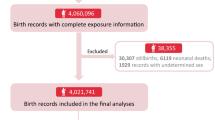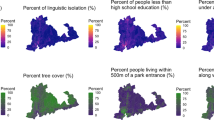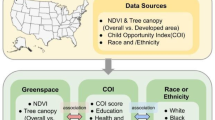Abstract
Background
Higher levels of neighborhood greenery have been associated with improved birth outcomes. However, many studies use metrics relying on vegetation density and are not able to distinguish types of greenery or spatial context, which may result in variation in potential benefits.
Objective
We examined relationships between term low birth weight (TLBW) and preterm birth (PTB), and different types of neighborhood greenery (i.e., tree cover, herbaceous cover, and aggregate greenery) within various spatial contexts (i.e., Euclidean distance and network distance-based buffers, and busy roadways to represent overall, street, and near-road greenery).
Methods
North Carolina birth registry data from 2003 to 2015 were used to create a singleton live birth cohort and linked to greenery metrics from EnviroAtlas. Logistic regression models were used to estimate OR (95%CI) for associations between greenery metrics and TLBW (<2500 g) or PTB (<37 weeks gestational age) adjusting for potential confounders. Analyses were stratified by race/ethnicity, as many studies report potential differences in proximity to greenery across these groups.
Results
We observed modest associations between multiple measures of neighborhood greenery and TLBW and PTB. Most of our results indicated a decreased odds of adverse birth outcomes with increasing levels of neighborhood greenery, but some associations showed increased odds of adverse birth outcomes. We observed the strongest associations between overall aggregate greenery with TLBW (0.967 [0.939, 0.996]) and near-road tree cover with PTB (0.985 [0.971, 0.999]). We also observed unexpected associations between increased greenway density and TLBW among non-Hispanic Black mothers (1.181 [1.049, 1.326]). In contrast, we observed a decreased odds of PTB associated with increased greenway density for non-Hispanic white mothers (0.926 [0.871, 0.983]).
Impact statement
We examined relationships between adverse birth outcomes and different types of neighborhood greenery, generally finding decreased odds of adverse birth outcomes with increasing levels of neighborhood greenery, with the strongest associations between aggregate greenery based on the Euclidean distance and decreased odds of term low birth weight. However, we also observed unexpected associations with increased greenway density and increased term low birth weight among non-Hispanic Black mothers. These results highlight the importance of considering the ways greenspace may or may not benefit some communities and will be important in guiding future efforts to increase instorative value or restore neighborhood greenspaces.
This is a preview of subscription content, access via your institution
Access options
Subscribe to this journal
Receive 6 print issues and online access
$259.00 per year
only $43.17 per issue
Buy this article
- Purchase on SpringerLink
- Instant access to full article PDF
Prices may be subject to local taxes which are calculated during checkout


Similar content being viewed by others
Data availability
Greenery data used are available through EPA’s Enviroatlas (EnviroAtlas | US EPA), North Carolina birth registry data contain PII and may be requested through the NCDHHS.
References
Crump C, Howell EA, Stroustrup A, McLaughlin MA, Sundquist J, Sundquist K. Association of preterm birth with risk of ischemic heart disease in adulthood. JAMA Pediatrics. 2019;173:736–43.
Lund LK, Vik T, Lydersen S, Løhaugen GCC, Skranes J, Brubakk A-M, et al. Mental health, quality of life and social relations in young adults born with low birth weight. Health Qual Life Outcomes. 2012;10:146.
Belbasis L, Savvidou MD, Kanu C, Evangelou E, Tzoulaki I. Birth weight in relation to health and disease in later life: an umbrella review of systematic reviews and meta-analyses. BMC Med. 2016;14:147.
Reyes L, Manalich R. Long-term consequences of low birth weight. Kidney Int. 2005;68:S107–S11.
Osterman MJ, Hamilton BE, Martin JA, Driscoll AK, Valenzuela CP. Births: final data for 2021. 2023;72.
Akaraci S, Feng X, Suesse T, Jalaludin B, Astell-Burt T. Greener neighbourhoods, healthier birth outcomes? Evidence from Australia. Environ Pollut. 2021:278:116814.
Bekkar B, Pacheco S, Basu R, DeNicola N. Association of air pollution and heat exposure with preterm birth, low birth weight, and stillbirth in the US: a systematic review. JAMA Netw Open. 2020;3:e208243–e.
Klepac P, Locatelli I, Korošec S, Künzli N, Kukec A. Ambient air pollution and pregnancy outcomes: a comprehensive review and identification of environmental public health challenges. Environ Res. 2018;167:144–59.
Torres Toda M, Avraam D, James Cadman T, Fossati S, de Castro M, Dedele A, et al. Exposure to natural environments during pregnancy and birth outcomes in 11 European birth cohorts. Environ Int. 2022;170:107648.
Nieuwenhuijsen MJ, Ristovska G, Dadvand P. WHO environmental noise guidelines for the European Region: a systematic review on environmental noise and adverse birth outcomes. Int J Environ Res Public Health. 2017;14:1252.
Twohig-Bennett C, Jones A. The health benefits of the great outdoors: a systematic review and meta-analysis of greenspace exposure and health outcomes. Environ Res. 2018;166:628–37.
van den Bosch M, Ode Sang Å. Urban natural environments as nature-based solutions for improved public health—a systematic review of reviews. Environ Res. 2017;158:373–84.
Markevych I, Schoierer J, Hartig T, Chudnovsky A, Hystad P, Dzhambov AM, et al. Exploring pathways linking greenspace to health: Theoretical and methodological guidance. Environ Res. 2017;158:301–17.
Xie Y, Fan S, Luo Y, Li J, Zhang Y, Hu L, et al. Credibility of the evidence on green space and human health: an overview of meta-analyses using evidence grading approaches. eBioMedicine. 2024;106.
Fong KC, Hart JE, James P. A review of epidemiologic studies on greenness and health: updated literature through 2017. Curr Environ health Rep. 2018;5:77–87.
Weber KA, Yang W, Carmichael SL, Collins RT, Luben TJ, Desrosiers TA, et al. Assessing associations between residential proximity to greenspace and birth defects in the National Birth Defects Prevention Study. Environ Res. 2023;216:114760.
Akaraci S, Feng X, Suesse T, Jalaludin B, Astell-Burt T. A systematic review and meta-analysis of associations between green and blue spaces and birth outcomes. Int J Environ Res Public Health. 2020;17:2949.
Dzhambov AMD, Donka D, Dimitrakova ED. Association between residential greenness and birth weight: Systematic review and meta-analysis. Urban Forestry Urban Green. 2014;13:621–9.
Zhan Y, Liu J, Lu Z, Yue H, Zhang J, Jiang Y. Influence of residential greenness on adverse pregnancy outcomes: A systematic review and dose-response meta-analysis. Sci Total Environ. 2020;718:137420.
Tzoulas K, Korpela K, Venn S, Yli-Pelkonen V, Kaźmierczak A, Niemela J, et al. Promoting ecosystem and human health in urban areas using green infrastructure: a literature review. Landsc Urban Plan. 2007;81:167–78.
Pinto LV, Inácio M, Ferreira CSS, Ferreira AD, Pereira P. Ecosystem services and well-being dimensions related to urban green spaces—a systematic review. Sustain Cities Soc. 2022;85:104072.
Balany F, Ng AW, Muttil N, Muthukumaran S, Wong MS. Green infrastructure as an urban heat island mitigation strategy—a review. Water. 2020;12:3577.
Bowler DE, Buyung-Ali L, Knight TM, Pullin AS. Urban greening to cool towns and cities: a systematic review of the empirical evidence. Landsc Urban Plan. 2010;97:147–55.
Skelhorn C, Lindley S, Levermore G. The impact of vegetation types on air and surface temperatures in a temperate city: a fine scale assessment in Manchester, UK. Landsc Urban Plan. 2014;121:129–40.
Kim Y-J, Lee C, Kim J-H. Sidewalk landscape structure and thermal conditions for child and adult pedestrians. Int J Environ Res Public Health. 2018;15:148.
Klemm W, Heusinkveld BG, Lenzholzer S, van Hove B. Street greenery and its physical and psychological impact on thermal comfort. Landsc Urban Plan. 2015;138:87–98.
Reid C, Clougherty J, Shmool J, Kubzansky L. Is all urban green space the same? A comparison of the health benefits of trees and grass in New York City. Int J Environ Res Public Health. 2017;14:1411.
Astell-Burt T, Feng X. Association of urban green space with mental health and general health among adults in Australia. JAMA Netw Open. 2019;2:e198209.
Tsai W-L, Davis AJS, Jackson LE. Associations between types of greenery along neighborhood roads and weight status in different climates. Urban forestry Urban Green. 2019;41:104–17.
Tsai W-L, Yngve L, Zhou Y, Beyer KMM, Bersch A, Malecki KM, et al. Street-level neighborhood greenery linked to active transportation: a case study in Milwaukee and Green Bay, WI, USA. Landsc Urban Plan. 2019;191:103619.
Feng X, Toms R, Astell-Burt T. Association between green space, outdoor leisure time and physical activity. Urban Forestry Urban Green. 2021;66:127349.
Ha J, Kim HJ, With KA. Urban green space alone is not enough: a landscape analysis linking the spatial distribution of urban green space to mental health in the city of Chicago. Landsc Urban Plan. 2022;218:104309.
Nguyen P-Y, Astell-Burt T, Rahimi-Ardabili H, Feng X. Green space quality and health: a systematic review. Int J Environ Res Public Health. 2021;18:11028.
James P, Berrigan D, Hart JE, Hipp JA, Hoehner CM, Kerr J, et al. Effects of buffer size and shape on associations between the built environment and energy balance. Health Place. 2014;27:162–70.
Oliver LN, Schuurman N, Hall AW. Comparing circular and network buffers to examine the influence of land use on walking for leisure and errands. Int J Health Geograp. 2007;6:1.
Boruff BJ, Nathan A, Nijenstein S. Using GPS technology to (re)-examine operational definitions of ‘neighbourhood’ in place-based health research. Int J Health Geogr. 2012;11:22.
Roscoe C, Sheridan C, Geneshka M, Hodgson S, Vineis P, Gulliver J, et al. Green walkability and physical activity in UK Biobank: a cross-sectional analysis of adults in Greater London. Int J Environ Res Public Health. 2022;19:4247.
Vich G, Marquet O, Miralles-Guasch C. Green streetscape and walking: Exploring active mobility patterns in dense and compact cities. J Transp Health. 2019;12:50–9.
Lu Y, Sarkar C, Xiao Y. The effect of street-level greenery on walking behavior: Evidence from Hong Kong. Soc Sci Med. 2018;208:41–9.
de Vries S, van Dillen SM, Groenewegen PP, Spreeuwenberg P. Streetscape greenery and health: stress, social cohesion and physical activity as mediators. Soc Sci Med. 2013;94:26-33.
Ahmer Z, Atif M, Zaheer S, Adil O, Shaikh S, Shafique K. Association between residential green spaces and pregnancy outcomes: a systematic review and meta-analysis. Int J Environ Health Res. 2024;34:3188–205.
Cusack L, Larkin A, Carozza SE, Hystad P. Associations between multiple green space measures and birth weight across two US cities. Health Place. 2017;47:36–43.
Wang H, Huang X, Hao H, Chang HH. Greenspace morphology and preterm birth: a state-wide study in Georgia, United States (2001–2016). Environ Health Persp. 2024;132:127001.
Donovan GH, Gatziolis D, Jakstis K, Comess S. The natural environment and birth outcomes: comparting 3D exposure metrics derived from LiDAR to 2D metrics based on the normalized difference vegetation index. Health Place. 2019;57:305–12.
Tvina A, Visser A, Walker SL, Tsaih S-W, Zhou Y, Beyer K, et al. Residential proximity to tree canopy and preterm birth in Black women. Am J Obstet Gynecol MFM. 2021;3:100391.
Pilant A, Endres K, Rosenbaum D, Gundersen G. US EPA EnviroAtlas meter-scale urban land cover (MULC): 1-m pixel land cover class definitions and guidance. Remote Sens. 2020;12:1909.
Bigsby K, McHale M, Hess G. Urban morphology drives the homogenization of tree cover in Baltimore, MD, and Raleigh, NC. Ecosystems. 2013;17:1-16.
Nokia-HERE. NavTEQ Streets [Esri File Geodatabase]. In: HERE N, editor. [Obtained from US EPA’s Office of Environmental Information, 201x.] ed. Chicago, IL2011.
ESRI Developer. How Focal Statistics works. Available at: https://pro.arcgis.com/en/pro-app/latest/tool-reference/spatial-analyst/how-focal-statistics-works.htm, retrieved on May 25, 2023.
The City and County of Durham. Durham Open Data Portal. Available at https://live-durhamnc.opendata.arcgis.com/. Accessed on 06/17/2021.
Wake County N Greenways in Wake County, NC. Available at https://www.arcgis.com/home/item.html?id=3f75595edc244c35812675b226021258. Accessed on 06/17/2021.
Orange County N Downloaded GIS Data. Available at https://www.orangecountync.gov/2057/Download-GIS-Data. Accessed on 06/17/2021.
Saporito S, Casey D. Are there relationships among racial segregation, economic isolation, and proximity to green space?. Hum Ecol Rev. 2015;21:113–32.
Fong KC, Kloog I, Coull BA, Koutrakis P, Laden F, Schwartz JD, et al. Residential greenness and birthweight in the state of Massachusetts, USA. Int J Environ Res Public Health. 2018;15:1248.
Kottek M, Grieser J, Beck C, Rudolf B, Rubel F. World map of the Köppen-Geiger climate classification updated. Meteorologische Z. 2006;15:259–63.
Abelt K, McLafferty S. Green streets: urban green and birth outcomes. Int J Environ Res Public Health. 2017;14:771.
Garcia-Vara J, Lopez-Feldman A, Marquez-Padilla F. The giving tree: impacts of deforestation on birth outcomes in Mexico. Appl Econ Lett. 1–5.
Ozdemir H. Mitigation impact of roadside trees on fine particle pollution. Sci Total Environ. 2019;659:1176–85.
Nowak DJ, Crane DE, Stevens JC. Air pollution removal by urban trees and shrubs in the United States. Urban Forestry Urban Green. 2006;4:115–23.
Kuo FE, Sullivan WC. Aggression and violence in the inner city. Environ Behav. 2001;33:543–71.
Taylor A, Wiley A, Kuo F, Sullivan W. Growing up in the inner city: green spaces as places to grow. Environ Behav. 1998;30:3–28.
Lima SAM, El Dib RP, Rodrigues MRK, Ferraz GAR, Molina AC, Neto CAP, et al. Is the risk of low birth weight or preterm labor greater when maternal stress is experienced during pregnancy? A systematic review and meta-analysis of cohort studies. Plos One. 2018;13:e0200594.
Rondó PHC, Ferreira RF, Nogueira F, Ribeiro MCN, Lobert H, Artes R. Maternal psychological stress and distress as predictors of low birth weight, prematurity and intrauterine growth retardation. Eur J Clin Nutr. 2003;57:266–72.
Ulrich RS. Aesthetic and affective response to natural environment. In: Altman I, Wohlwill J, editors. Human Behavior and the Natural Environment. 6. New York: Springer; 1983. p. 85-125.
Ulrich RS, Simons RF, Losito BD, Fiorito E, Miles M, Zelson M. Stress recovery during exposure to natural and urban environments. J Environ Psychol. 1991;11:201–30.
Egorov AI, Griffin SM, Converse RR, Styles JN, Klein E, Scott J, et al. Greater tree cover near residence is associated with reduced allostatic load in residents of central North Carolina. Environ Res. 2020;186:109435.
Acknowledgements
The authors would like to thank Drs. Andrey Egorov and Caitlin Gould for their review and input, and Ms. Debora Andrews for QA review. The views expressed in this article are those of the author(s) and do not necessarily represent the views or policies of the US Environmental Protection Agency.
Funding
This work was performed as part of normal duties at the U.S. Environmental Protection Agency.
Author information
Authors and Affiliations
Contributions
All authors conceived study and designed analyses. TJL and WLT acquired data. WLT and KMR processed data. WLT performed analysis with guidance from TJL and KMR. WLT wrote initial manuscript draft. TJL and KMR revised manuscript.
Corresponding author
Ethics declarations
Competing interests
The authors declare no competing interests.
Ethical approval
This study protocol was approved by the Institutional Review Boards of the University of North Carolina at Chapel Hill UNC (IRB Number: 09-0828) and the NC Division of Public Health. The EPA’s Human Subjects Research Officer also reviewed and approved this work (HSR-001254). This analysis was secondary data, and informed consent was not required. All methods were performed in accordance with the relevant guidelines and regulations.
Additional information
Publisher’s note Springer Nature remains neutral with regard to jurisdictional claims in published maps and institutional affiliations.
Supplementary information
Rights and permissions
About this article
Cite this article
Tsai, WL., Luben, T.J. & Rappazzo, K.M. Associations between neighborhood greenery and birth outcomes in a North Carolina cohort. J Expo Sci Environ Epidemiol 35, 821–830 (2025). https://doi.org/10.1038/s41370-025-00780-4
Received:
Revised:
Accepted:
Published:
Issue date:
DOI: https://doi.org/10.1038/s41370-025-00780-4



